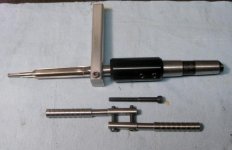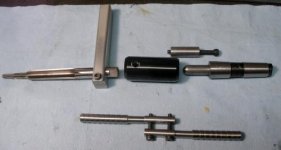Jerry and Al,
Okay...if I'm understanding your reamer pushers correctly, you're pushing a flat surface with a flat surface. Whereas with my Bald Eagle, I'm pushing a flat surface with a rounded (convex) surface. Correct?
So, with the flat on flat pusher, any angular mis-alignment causes the "pushed" surface (back of the reamer/reamer holder) to lose full contact with the "pusher" surface, but counteracts this mis-alignment, resulting in the "high side" push as alluded to by Al. Yes?
Justin
Okay...if I'm understanding your reamer pushers correctly, you're pushing a flat surface with a flat surface. Whereas with my Bald Eagle, I'm pushing a flat surface with a rounded (convex) surface. Correct?
So, with the flat on flat pusher, any angular mis-alignment causes the "pushed" surface (back of the reamer/reamer holder) to lose full contact with the "pusher" surface, but counteracts this mis-alignment, resulting in the "high side" push as alluded to by Al. Yes?
Justin



